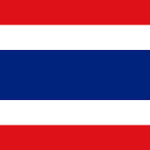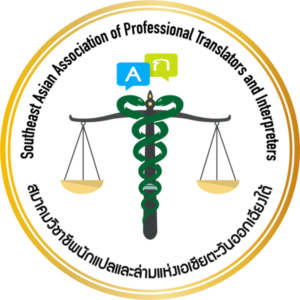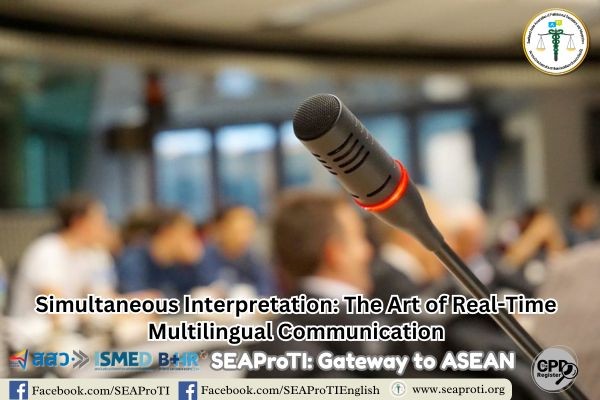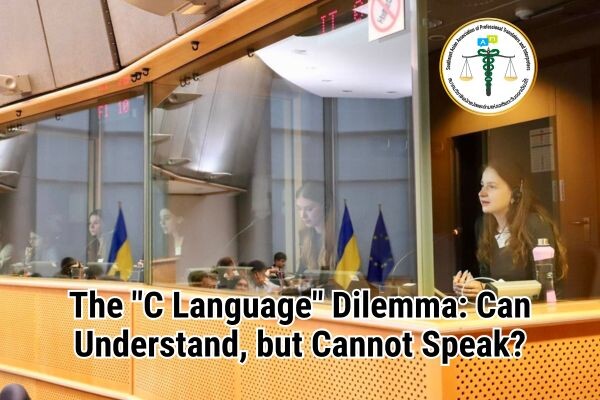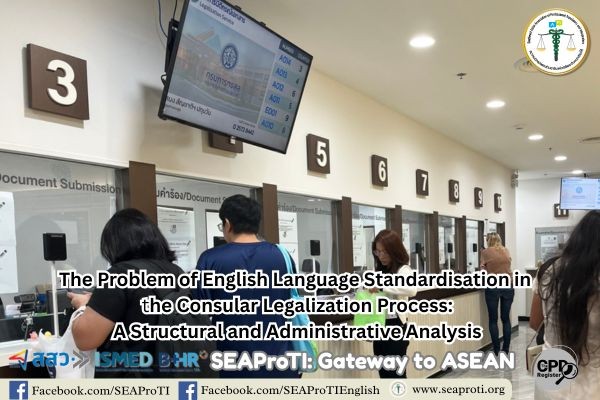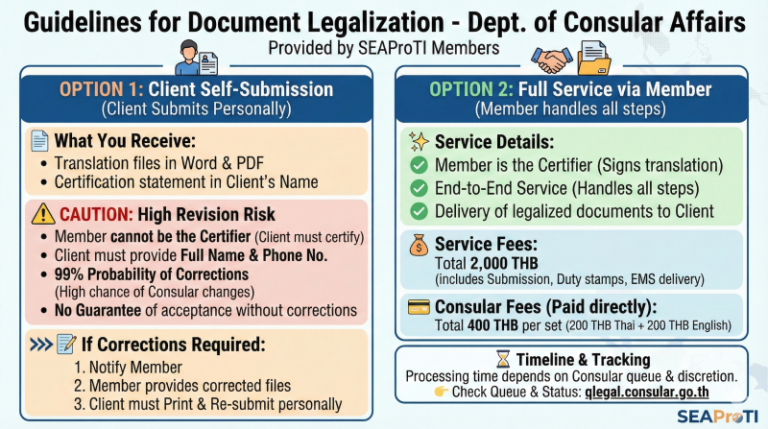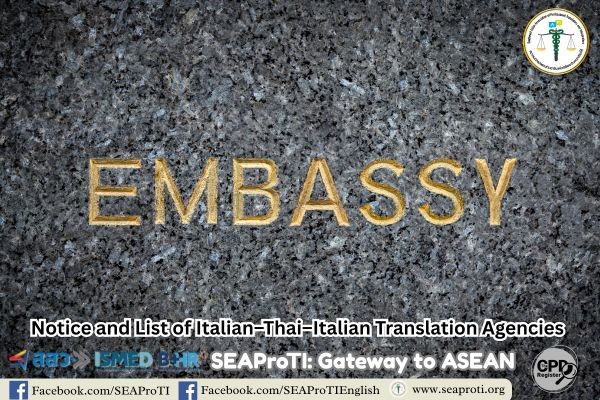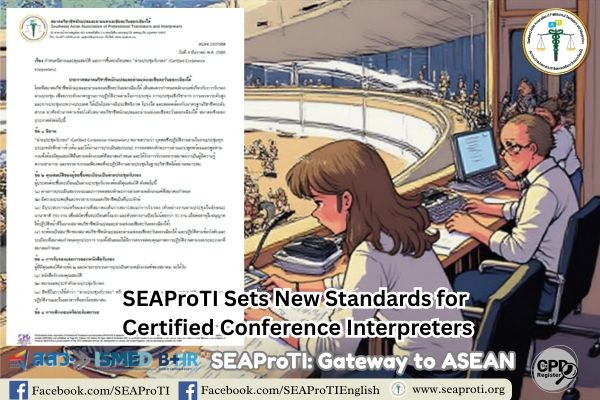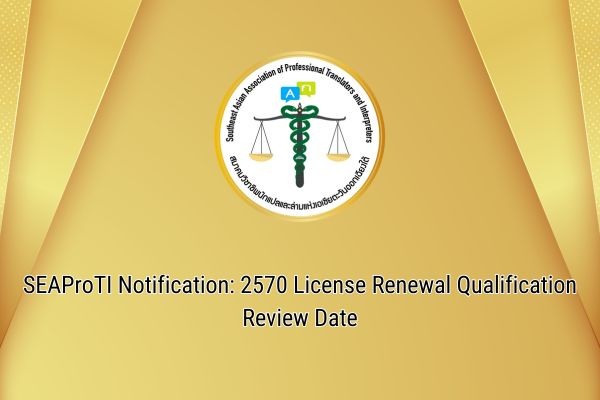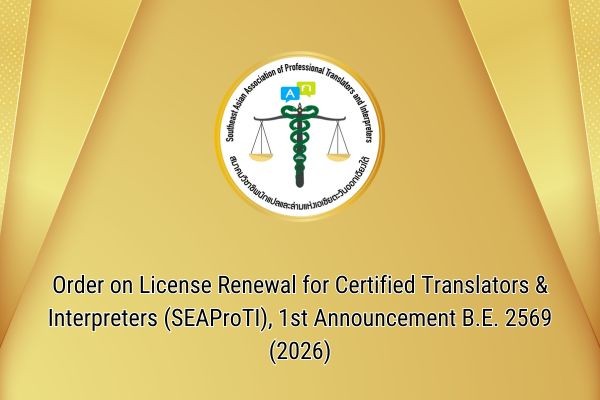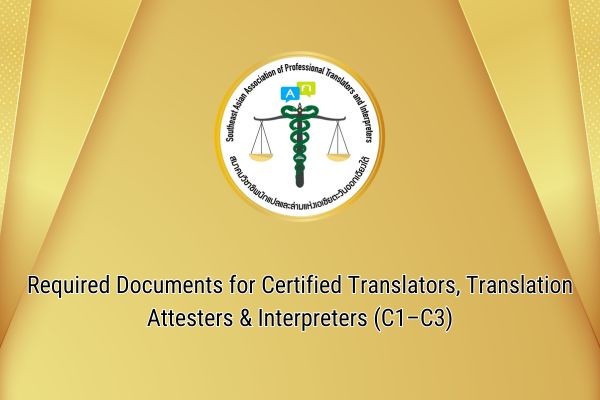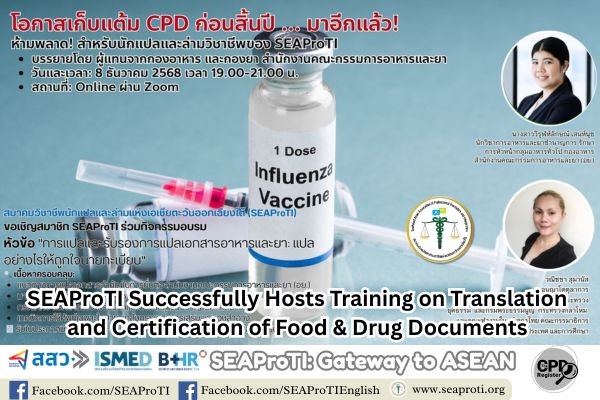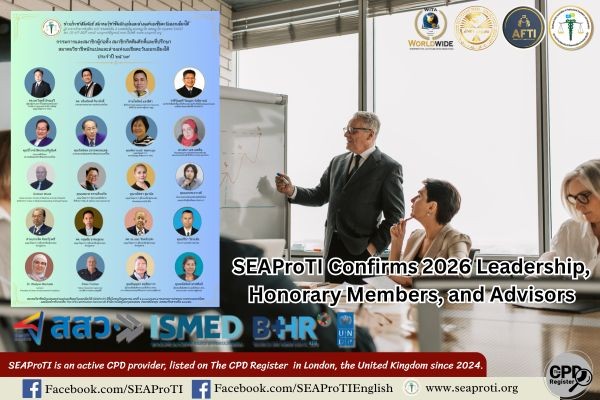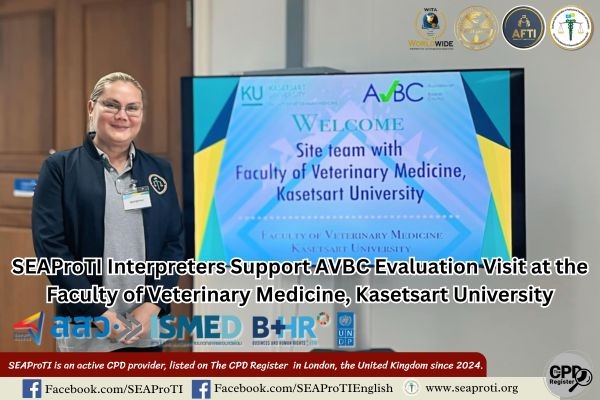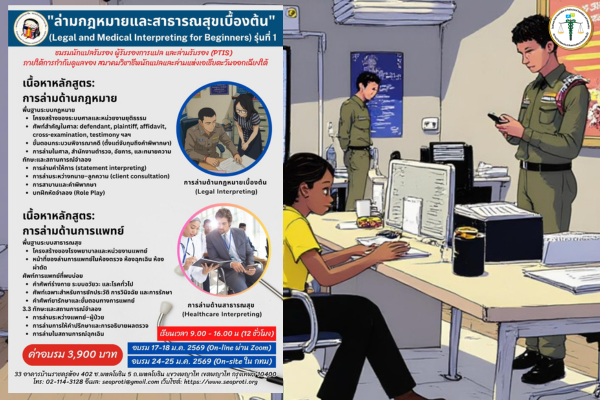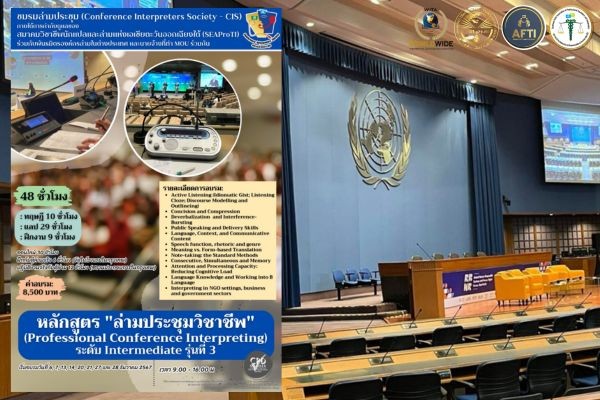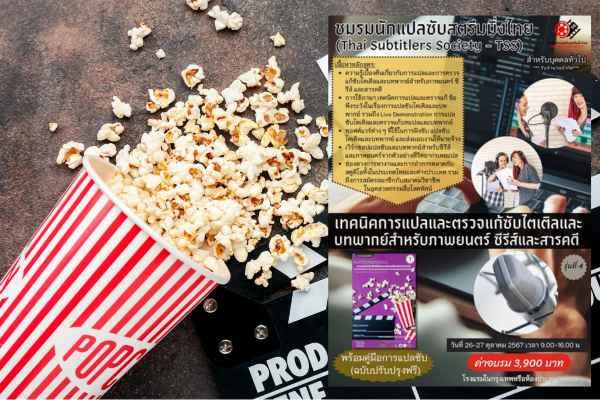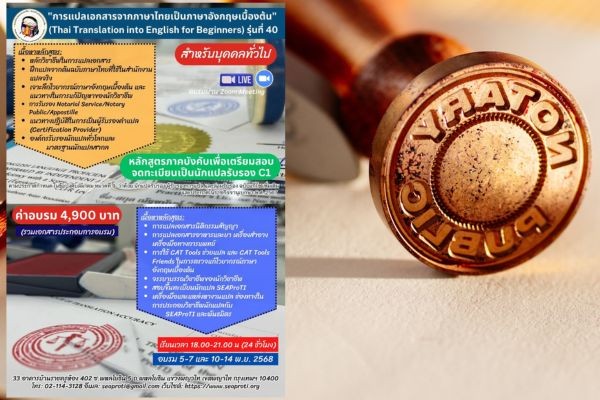Simultaneous Interpretation: The Art of Real-Time Multilingual Communication
29 October 2025, Bangkok – Simultaneous interpretation (SI) is one of the most sophisticated forms of language mediation. It allows communication to flow naturally between speakers of different languages in real time. As the speaker delivers their message, the interpreter listens, processes, and simultaneously renders the speech into another language. This seamless process requires an exceptional degree of concentration, linguistic accuracy, and technical coordination between interpreters, equipment, and event organizers (Pöchhacker, 2016).
The Essence of Simultaneous Interpretation
Unlike consecutive interpretation, where the interpreter waits until the speaker finishes a segment before rendering the message, simultaneous interpretation occurs almost instantaneously. This real-time nature makes SI ideal for multilingual conferences, international summits, and live broadcasts. The interpreter usually works inside a soundproof booth, listens through a headset, and speaks into a microphone connected to the audience’s receivers (Gile, 2009).
The interpreter’s brain performs three tasks concurrently—listening, understanding, and producing speech—often with a lag of only two to three seconds. This complex coordination requires not only fluency in both languages but also advanced cognitive control, anticipation skills, and the ability to remain calm under pressure.
The Professional Team and Setup
Due to the high mental demand, simultaneous interpreters typically work in pairs, alternating every 20 to 30 minutes to maintain accuracy and focus (AIIC, 2023). A successful interpretation session depends on several factors: the interpreters’ language pair, expertise in the subject matter, cultural familiarity, and the event’s thematic context.
Equally essential is the technical setup. Professional simultaneous interpretation requires specialized equipment, including interpreter booths, headsets, microphones, and control units. These ensure that interpreters can hear the speaker clearly and that the audience receives the translated message without distortion. Technical staff often remain on-site throughout the event to monitor the system and prevent interruptions (Donovan, 2017).
Modes and Contexts of Application
Simultaneous interpretation is used across diverse settings—international conferences, corporate meetings, governmental and non-governmental forums, and academic symposia. In smaller or private settings, “whispered interpretation” (chuchotage) is sometimes employed, where the interpreter sits next to the listener and quietly renders the message without using equipment. This method is especially useful for bilateral meetings or diplomatic consultations (Jones, 2018).
In the digital era, remote simultaneous interpretation (RSI) has become increasingly common. Platforms such as Zoom, Webex, and Interprefy allow interpreters to work from remote booths or even from home, connecting to global audiences in real time. RSI eliminates geographical limitations and provides a cost-effective solution for multilingual engagement (Mellinger & Hanson, 2020).
Skills and Ethical Considerations
Simultaneous interpreting is not merely a linguistic task; it is a professional art grounded in ethics and precision. Interpreters must maintain confidentiality, neutrality, and accuracy at all times. They are expected to adhere to professional standards established by organizations such as the International Association of Conference Interpreters (AIIC) and national associations like SEAProTI (Southeast Asian Association of Professional Translators and Interpreters). Continuous professional development and practice are essential for interpreters to remain competent in a rapidly evolving multilingual environment.
Conclusion
Simultaneous interpretation represents the pinnacle of professional interpreting, combining linguistic mastery, technical coordination, and intercultural sensitivity. It is an indispensable tool for diplomacy, international business, and global communication. As technology advances, the field continues to evolve bridging voices across languages and cultures in real time.
References
- AIIC. (2023). Professional standards for conference interpreters. International Association of Conference Interpreters. https://aiic.org
- Donovan, C. (2017). Interpreting simultaneously: Theory and practice in conference settings. Routledge.
- Gile, D. (2009). Basic concepts and models for interpreter and translator training (Rev. ed.). John Benjamins.
- Jones, R. (2018). Conference interpreting explained (2nd ed.). Routledge.
- Mellinger, C. D., & Hanson, T. A. (2020). Interpreter-mediated communication in the digital age: Remote and hybrid practices. Translation and Interpreting Studies, 15(3), 321–340.
- Pöchhacker, F. (2016). Introducing interpreting studies (2nd ed.). Routledge.
About Certified Translators, Translation Certifiers, and Certified Interpreters of SEAProTI
The Southeast Asian Association of Professional Translators and Interpreters (SEAProTI) has formally announced the qualifications and requirements for registration of Certified Translators, Translation Certification Providers, and Certified Interpreters in Sections 9 and 10 of the Royal Gazette, published by the Secretariat of the Cabinet, Office of the Prime Minister of Thailand, on 25 July 2024 (Vol. 141, Part 66 Ng, p. 100). Certified Translators, Translation Certification Providers, and Certified Interpreters
The Council of State has proposed the enactment of a Royal Decree, granting registered translators and recognized translation certifiers from professional associations or accredited language institutions the authority to provide legally valid translation certification (Letter to SEAProTI dated April 28, 2025)
SEAProTI is the first professional association in Thailand and Southeast Asia to implement a comprehensive certification system for translators, certifiers, and interpreters.
Head Office: Baan Ratchakru Building, No. 33, Room 402, Soi Phahonyothin 5, Phahonyothin Road, Phaya Thai District, Bangkok 10400, Thailand
Email: hello@seaproti.com | Tel.: (+66) 2-114-3128 (Office hours: Mon–Fri, 09:00–17:00)
การล่ามพูดพร้อม: ศิลปะแห่งการสื่อสารหลายภาษาทันเวลา
การล่ามพูดพร้อม (Simultaneous Interpretation) เป็นหนึ่งในรูปแบบการถ่ายทอดภาษาที่ซับซ้อนที่สุดในวงการล่าม เพราะเป็นกระบวนการที่ผู้พูดและล่ามสื่อสารไปพร้อมกันแบบเรียลไทม์ ผู้พูดยังคงพูดต่อเนื่อง ในขณะที่ล่ามฟัง ประมวลผล และแปลความหมายออกมาในอีกภาษาทันที กระบวนการดังกล่าวต้องอาศัยทั้งความชำนาญทางภาษา การฝึกฝนอย่างเข้มข้น และการประสานงานอย่างมีประสิทธิภาพระหว่างล่าม อุปกรณ์ และผู้จัดงาน (Pöchhacker, 2016)
แก่นของการล่ามพูดพร้อม
ต่างจากการล่ามแบบพูดตาม (Consecutive Interpretation) ที่ล่ามรอให้ผู้พูดจบข้อความก่อน การล่ามพูดพร้อมจะเกิดขึ้นทันทีในขณะที่ผู้พูดยังกล่าวอยู่ เหมาะอย่างยิ่งสำหรับงานประชุมหลายภาษา การประชุมสุดยอดระหว่างประเทศ หรือการถ่ายทอดสดทางสื่อมวลชน
โดยทั่วไป ล่ามจะนั่งอยู่ในห้องเก็บเสียง (Booth) ฟังผู้พูดผ่านหูฟัง และพูดผ่านไมโครโฟนที่เชื่อมต่อกับเครื่องรับของผู้ฟัง (Gile, 2009) สมองของล่ามต้องทำงาน 3 อย่างในเวลาเดียวกัน ได้แก่ “ฟัง → เข้าใจ → พูดออกมา” โดยมีช่วงเวลาหน่วงเพียง 2–3 วินาที ซึ่งต้องอาศัยสมาธิสูง ความสามารถในการคาดการณ์ และการควบคุมอารมณ์อย่างดีเยี่ยม
ทีมงานและการจัดเตรียมระบบ
เนื่องจากงานล่ามพูดพร้อมใช้พลังสมองและความเครียดสูง ล่ามจึงมักทำงานเป็นคู่ โดยผลัดกันพูดทุก 20–30 นาที เพื่อรักษาความแม่นยำและความสดของสมาธิ (AIIC, 2023) ความสำเร็จของงานขึ้นอยู่กับหลายปัจจัย เช่น คู่ภาษาของล่าม ความเชี่ยวชาญเฉพาะด้าน วัฒนธรรมที่เกี่ยวข้อง และหัวข้อของการประชุม
นอกจากล่ามแล้ว การจัดระบบเทคนิคก็เป็นหัวใจสำคัญ การล่ามพูดพร้อมต้องใช้อุปกรณ์เฉพาะ เช่น ห้องล่าม หูฟัง ไมโครโฟน และชุดควบคุมเสียง เพื่อให้การรับ–ส่งสัญญาณเป็นไปอย่างราบรื่น เจ้าหน้าที่เทคนิคมักอยู่ประจำตลอดงานเพื่อดูแลระบบและแก้ไขปัญหาที่อาจเกิดขึ้น (Donovan, 2017)
รูปแบบและบริบทการใช้งาน
การล่ามพูดพร้อมถูกนำมาใช้ในหลายบริบท ทั้งในการประชุมระหว่างประเทศ การเจรจาทางธุรกิจ การสัมมนาทางวิชาการ และการประชุมขององค์กรระหว่างประเทศ สำหรับงานขนาดเล็กหรือต้องการความเป็นส่วนตัว มักใช้ “การล่ามกระซิบ” (Whispered Interpretation หรือ Chuchotage) ซึ่งล่ามจะนั่งข้างผู้ฟังและแปลเสียงเบา ๆ โดยไม่ใช้อุปกรณ์ เหมาะกับการประชุมทางการทูตหรือการเจรจาธุรกิจที่ต้องการความกระชับ (Jones, 2018)
ในยุคดิจิทัล การล่ามพูดพร้อมแบบ ออนไลน์ (Remote Simultaneous Interpretation: RSI) ได้รับความนิยมมากขึ้นผ่านแพลตฟอร์มอย่าง Zoom, Webex หรือ Interprefy ช่วยให้ล่ามทำงานจากระยะไกลได้แบบเรียลไทม์ ลดข้อจำกัดทางภูมิศาสตร์ และเป็นทางเลือกที่คุ้มค่ากว่าสำหรับงานหลายภาษา (Mellinger & Hanson, 2020)
ทักษะและจรรยาบรรณวิชาชีพ
การล่ามพูดพร้อมไม่ใช่เพียงการแปลภาษา แต่เป็นศิลปะแห่งวิชาชีพที่ตั้งอยู่บนจรรยาบรรณ ความแม่นยำ และความเป็นกลาง ล่ามต้องรักษาความลับของข้อมูล ไม่แทรกความคิดเห็นส่วนตัว และรักษามาตรฐานตามหลักสากล เช่น สมาคมล่ามการประชุมนานาชาติ (AIIC) และในระดับภูมิภาค เช่น สมาคมนักแปลและล่ามอาชีพแห่งเอเชียตะวันออกเฉียงใต้ (SEAProTI) นอกจากนี้ ล่ามควรพัฒนาทักษะอย่างต่อเนื่องเพื่อให้เท่าทันเทคโนโลยีและความเปลี่ยนแปลงของโลกภาษา
สรุป
การล่ามพูดพร้อมถือเป็นจุดสูงสุดของวิชาชีพล่าม เพราะต้องอาศัยทั้งทักษะทางภาษา ความเข้าใจทางวัฒนธรรม และการทำงานร่วมกับเทคโนโลยีอย่างมีประสิทธิภาพ เป็นเครื่องมือสำคัญของการสื่อสารระหว่างประเทศ การทูต และธุรกิจโลกยุคใหม่ และเมื่อเทคโนโลยีก้าวหน้า ศาสตร์แห่งการล่ามพูดพร้อมก็จะยังคงพัฒนาอย่างต่อเนื่อง เพื่อเชื่อมโยงเสียงของผู้คนจากทุกภาษาเข้าด้วยกันอย่างไร้พรมแดน
บรรณานุกรม (รูปแบบ APA, 7th Edition)
- AIIC. (2023). Professional standards for conference interpreters. International Association of Conference Interpreters. https://aiic.org
- Donovan, C. (2017). Interpreting simultaneously: Theory and practice in conference settings. Routledge.
- Gile, D. (2009). Basic concepts and models for interpreter and translator training (Rev. ed.). John Benjamins.
- Jones, R. (2018). Conference interpreting explained (2nd ed.). Routledge.
- Mellinger, C. D., & Hanson, T. A. (2020). Interpreter-mediated communication in the digital age: Remote and hybrid practices. Translation and Interpreting Studies, 15(3), 321–340.
- Pöchhacker, F. (2016). Introducing interpreting studies (2nd ed.). Routledge.
เกี่ยวกับนักแปลรับรอง ผู้รับรองการแปล และล่ามรับรองของสมาคมวิชาชีพนักแปลและล่ามแห่งเอเชียตะวันออกเฉียงใต้
สมาคมวิชาชีพนักแปลและล่ามแห่งเอเชียตะวันออกเฉียงใต้ (SEAProTI) ได้ประกาศหลักเกณฑ์และคุณสมบัติผู้ที่ขึ้นทะเบียนเป็น “นักแปลรับรอง (Certified Translators) และผู้รับรองการแปล (Translation Certification Providers) และล่ามรับรอง (Certified Interpreters)” ของสมาคม หมวดที่ 9 และหมวดที่ 10 ในราชกิจจานุเบกษา ของสำนักเลขาธิการคณะรัฐมนตรี ในสำนักนายกรัฐมนตรี แห่งราชอาณาจักรไทย ลงวันที่ 25 ก.ค. 2567 เล่มที่ 141 ตอนที่ 66 ง หน้า 100 อ่านฉบับเต็มได้ที่: นักแปลรับรอง ผู้รับรองการแปล และล่ามรับรอง
สำนักคณะกรรมการกฤษฎีกาเสนอให้ตราเป็นพระราชกฤษฎีกา โดยกำหนดให้นักแปลที่ขึ้นทะเบียน รวมถึงผู้รับรองการแปลจากสมาคมวิชาชีพหรือสถาบันสอนภาษาที่มีการอบรมและขึ้นทะเบียน สามารถรับรองคำแปลได้ (จดหมายถึงสมาคม SEAProTI ลงวันที่ 28 เม.ย. 2568)
สมาคมวิชาชีพนักแปลและล่ามแห่งเอเชียตะวันออกเฉียงใต้ เป็นสมาคมวิชาชีพแห่งแรกในประเทศไทยและภูมิภาคเอเชียตะวันออกเฉียงใต้ที่มีระบบรับรองนักแปลรับรอง ผู้รับรองการแปล และล่ามรับรอง
สำนักงานใหญ่: อาคารบ้านราชครู เลขที่ 33 ห้อง 402 ซอยพหลโยธิน 5 ถนนพหลโยธิน แขวงพญาไท เขตพญาไท กรุงเทพมหานคร 10400 ประเทศไทย
อีเมล: hello@seaproti.com โทรศัพท์: (+66) 2-114-3128 (เวลาทำการ: วันจันทร์–วันศุกร์ เวลา 09.00–17.00 น.)
